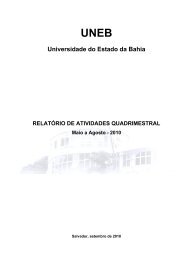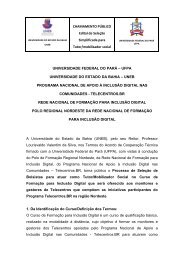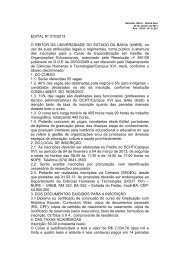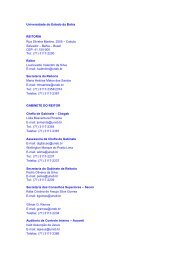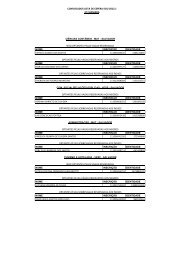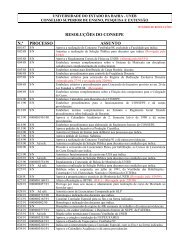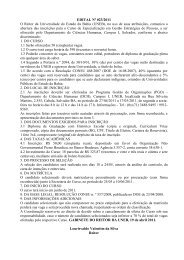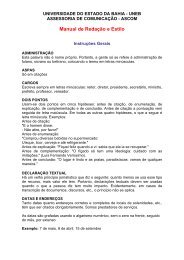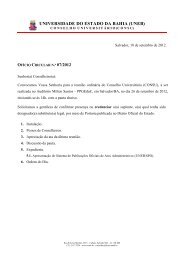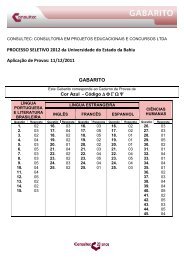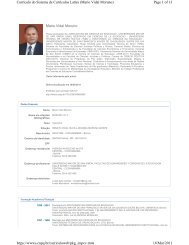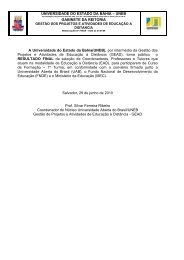Revista da FAEEBA Educação e Contemporaneidade - Uneb
Revista da FAEEBA Educação e Contemporaneidade - Uneb
Revista da FAEEBA Educação e Contemporaneidade - Uneb
You also want an ePaper? Increase the reach of your titles
YUMPU automatically turns print PDFs into web optimized ePapers that Google loves.
displaced by the “flood” of Mexican immigrants<br />
as the culprits likely to bring down the nation.<br />
The well-read magazine Foreign Policy recently<br />
printed excerpts from Who Are We by Samuel<br />
Huntington (2004b), Chairman of the<br />
Harvard Academy for International and Area<br />
Studies, in which the author sounds the alarm<br />
against Hispanic immigration. “One index foretells<br />
the future,” he warns ominously, “In 1998,<br />
‘Jose’ replaced ‘Michael’ as the most popular<br />
name for newborn boys in both California and<br />
Texas” (HUNTINGTON, 2004a, p.38).<br />
The persistent influx of Hispanic immigrants<br />
threatens to divide the United States into two<br />
peoples, two cultures, and two languages. Unlike<br />
past immigrant groups, Mexicans and other<br />
Latinos have not assimilated into mainstream<br />
U.S. culture, forming instead their own political<br />
and linguistic enclaves – from Los Angeles to<br />
Miami – and rejecting the Anglo-Protestant<br />
values that built the American dream. The United<br />
States ignores this challenge at its peril.<br />
(HUNTINGTON, 2004a, p.30)<br />
Responding to the outcry over Huntington’s<br />
article, Patrick Buchanan, well-known spokesperson<br />
for right-wing causes and editor of The<br />
American Conservative, concurred:<br />
Will the U.S. Southwest cease to be truly American<br />
by mid-century? Is Mexifornia reality and<br />
Mexamerica 22 a certainty? (…) It is impossible to<br />
see who, or what, is going to stop the invasion of<br />
the United States before the nation’s character is<br />
altered forever, and we become two nations with<br />
two languages and cultures – not unlike the<br />
Palestinians and Israelis on the West Bank.<br />
(BUCHANAN, 2004)<br />
Huntington further argued that working class<br />
and middle class “white nationalism” in response<br />
to loss of jobs, government affirmative action<br />
programs, and perceived cultural and<br />
linguistic threats from the expanding power of<br />
Hispanics may be moving the U.S. toward racial<br />
conflict without precedent in our history.<br />
Continuation of large-scale immigration:<br />
… could divide the United States into a country<br />
of two languages and two cultures…. There is<br />
no Americano dream. There is only the American<br />
dream created by an Anglo-Protestant society.<br />
Ellen Bigler<br />
Mexican Americans will share in that dream and<br />
in that society only if they dream in English.<br />
(HUNTINGTON, 2004a, p.44-45)<br />
Such arguments reflect an ignorance of,<br />
or willingness to ignore, our immigration and<br />
national history and the changing international<br />
scene. Hispanics are not “invading” the United<br />
States: The percentage of the U.S. that is foreign<br />
born to<strong>da</strong>y, 12.4 percent (U.S. Census<br />
Bureau American Community Survey, 2005),<br />
is lower than in 1890, when 14.8 percent of<br />
Americans were foreign-born (SUÁREZ-<br />
OROZCO and ORFIELD, 2004). Three in five<br />
Hispanics are native-born U.S. citizens, and over<br />
20 percent of immigrants were naturalized by<br />
2002 (DANIELS, 2004). Hispanics are not rejecting<br />
education and choosing to remain impoverished:<br />
Immigrant children are completing<br />
more years of school than did immigrants a century<br />
ago (SUÁREZ-OROZCO and ORFIELD,<br />
2004). Latin American “fatalism” is not about<br />
to create a separate cultural divide within the<br />
nation: Three-quarters of English-speaking Latina/os<br />
(the same percentage as the general<br />
population) disagree with the statement “It<br />
doesn’t do any good to plan for the future because<br />
you don’t have any control over it”<br />
(SURO, 2004). As for the charge that Hispanics<br />
are not hard-working and in pursuit of the<br />
American Dream, while most came to the U.S.<br />
with nothing, 78.6 percent of Hispanics to<strong>da</strong>y<br />
live above the poverty line (DANIELS, 2004).<br />
A recent survey by National Council of La Raza<br />
(2004) found that fully 90 percent strongly or<br />
somewhat agreed with the statement “If you<br />
work hard, you will succeed in America,” and<br />
89 percent strongly agreed that “It is important<br />
that Latina/o children get a college education.”<br />
Finally, while Latinos do tend to value speaking<br />
two languages, they are not the first<br />
American immigrants to want to maintain their<br />
native language. German immigrants – the very<br />
model of successful assimilation – from the<br />
colonial era through the early 1900s created lar-<br />
22 The terms “Mexifornia” and “Mexamerica” combine the<br />
words Mexico with California and America, signifying the<br />
“takeover” by Mexicans.<br />
<strong>Revista</strong> <strong>da</strong> <strong>FAEEBA</strong> – <strong>Educação</strong> e Contemporanei<strong>da</strong>de, Salvador, v. 15, n. 25, p. 239-257, jan./jun., 2006 251



